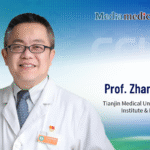
From November 6 to 9, 2025, the China Conference on Holistic and Integrative Oncology (CCHIO 2025) was successfully held in Kunming. As one of the largest and most influential oncology conferences in China, this year’s meeting brought together leading domestic and international oncology experts to discuss the future of cancer prevention and treatment through the lens of integrative medicine. The conference served as a high-level platform for accelerating China’s comprehensive cancer-care system.
During the conference, Oncology Frontier – Hematology Frontier conducted an in-depth interview with Professor Zhu Jun of Peking University Cancer Hospital. The discussion centered on the current landscape of CAR-T therapy in China, cutting-edge technological innovation, and strategies for overcoming clinical bottlenecks — offering a uniquely Chinese perspective to inform global advancements in cellular therapy.
Q1
As a leading expert in CAR-T therapy in China, could you summarize the current status of CAR-T treatment for lymphoma in China? How do domestically manufactured CAR-T products perform clinically, and what distinctive advantages do they have compared with international products?
Professor Zhu Jun:
At present, two CAR-T products for lymphoma have been approved in China — developed respectively by Fosun Kite and JW Therapeutics. These products use core technologies derived from the same platforms as approved international CAR-T therapies. Strictly speaking, a fully homegrown Chinese CAR-T product has not yet been approved, although several candidates have completed clinical trials. Encouragingly, one or two of these products have demonstrated strong potential and are expected to receive approval as early as the first half of next year.
Globally, there are 3–4 approved CAR-T products for lymphoma. The two CAR-Ts approved in China, because they originated from international technologies, are still priced relatively high. This limits real-world accessibility, making affordability the most significant barrier preventing widespread use in China.
To expand access, China must:
- Accelerate independent R&D and approval of domestically developed CAR-T products
- Promote market competition to lower costs
- Ensure supportive national health insurance policies to reduce patient burden
In terms of technology and clinical application, China’s overall CAR-T capabilities are not far behind the United States. Both countries lead globally in:
- scale of clinical use
- number of treated cases
- scope of technical applications
- exploration of innovative treatment strategies
Going forward, priorities include:
- strengthening the integration and analysis of clinical data,
- enhancing long-term follow-up on efficacy and safety, and
- accelerating product approvals of new cell therapies.
Building robust systems to ensure patient access will be critical to China’s high-quality development and widespread clinical adoption of CAR-T therapy.
Q2
What are the major technological innovations China is pursuing in CAR-T therapy? How promising are approaches such as dual-target CAR-T, allogeneic “off-the-shelf” CAR-T, or combination therapies in lymphoma?
Professor Zhu Jun:
China’s CAR-T innovation efforts currently focus on four major goals: enhancing safety, improving efficacy, increasing accessibility, and reducing costs.
1. Allogeneic “universal” CAR-T is a major frontier.
By bypassing the individualized manufacturing required for autologous CAR-T, allogeneic products aim to:
- enable standardized batch production,
- shorten manufacturing time, and
- significantly lower costs.
Several related clinical trials in China are progressing steadily.
2. Multi-target and function-enhanced CAR-T technologies
These include:
- dual-target CAR-T,
- armored CAR-T,
- and other advanced constructs designed to improve antigen coverage, overcome tumor escape, and strengthen cellular persistence.
These innovations aim to further improve treatment outcomes.
3. Multi-path innovation ecosystem
China’s CAR-T advancement now takes place on multiple parallel fronts:
- Promoting early approval of promising products through active clinical trials
- Pursuing new iterations including allogeneic, dual-target, and armored CAR-T
- Receiving increasing national support for regulatory review, reimbursement policies, and application pathways
With innovation, policy, and payment mechanisms advancing together, CAR-T therapy in China has a broad and promising future.
Q3
Despite its success, CAR-T therapy in lymphoma still faces challenges, such as variable patient response and early relapse in some cases. What do you consider the key contributing factors? What will be China’s research priorities moving forward to overcome these “hard obstacles”?
Professor Zhu Jun:
One key strategy is to combine CAR-T therapy with existing treatments at the optimal time. The goal is to enhance:
- safety,
- efficacy,
- durability of response, and
- clinical accessibility.
The essence of combination therapy is to identify the ideal treatment window and design rational combination regimens that maximize CAR-T activity while extending its therapeutic durability — ultimately improving long-term disease control and cure rates.
Across China, researchers are conducting numerous combination therapy trials, producing a continuous stream of new data. These studies are worth close attention. With scientific rigor, innovation, and clinical experience, we will eventually develop combination strategies with Chinese characteristics, and integrate them more efficiently into real-world practice.
Expert Profile

Professor Zhu Jun Peking University Cancer Hospital
- Secretary of the Party Committee, Peking University Cancer Hospital
- Director of Internal Medicine and Director of the Lymphoma Department
- Vice President, Chinese Society of Clinical Oncology (CSCO)
- Vice Chair of the Supervisory Board, CSCO
- Vice President, Beijing Xisike Clinical Oncology Research Foundation
- Former Chair, CSCO Lymphoma Committee
- Vice President, Beijing Anti-Cancer Association
- President, Beijing Cancer Rehabilitation Society
- Vice Chair, Chinese Medical Association Oncology Branch
- Head, Hematologic Oncology Group, National Health Commission Oncology Expert Committee


